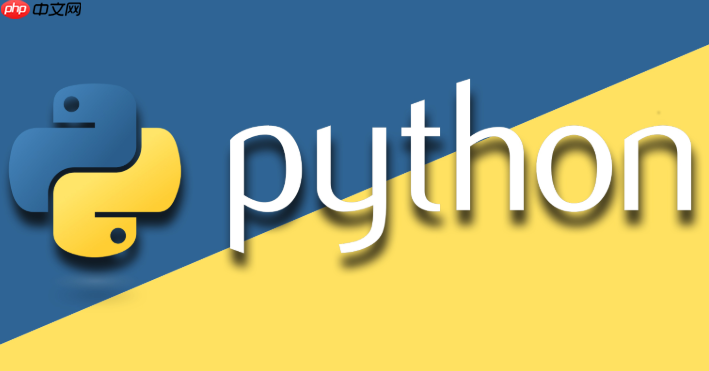使用scipy、opencv或numpy可实现二维卷积:1. SciPy的convolve2d支持多种模式与边界处理;2. OpenCV的filter2D自动处理填充,适合图像滤波;3. 手动实现可理解滑动窗口机制;4. 不同卷积核实现模糊、边缘检测、锐化等效果。

在二维图像上进行卷积是图像处理和深度学习中的常见操作,主要用于边缘检测、模糊、锐化等任务。python 中可以通过多种方式实现二维卷积,最常用的是使用 NumPy 手动实现,或借助 SciPy、OpenCV 等库快速完成。
1. 使用 SciPy 进行二维卷积
SciPy 提供了 scipy.signal.convolve2d 函数,专门用于二维卷积,使用简单且高效。
示例代码:
import numpy as np from scipy import signal <h1>创建一个简单的 5x5 图像(灰度图)</h1><p>image = np.array([[0, 0, 0, 0, 0], [0, 1, 1, 1, 0], [0, 1, 1, 1, 0], [0, 1, 1, 1, 0], [0, 0, 0, 0, 0]])</p><h1>定义卷积核(例如:边缘检测)</h1><p>kernel = np.array([[-1, -1, -1], [-1, 8, -1], [-1, -1, -1]])</p><h1>进行卷积</h1><p>conv_result = signal.convolve2d(image, kernel, mode='same', boundary='fill', fillvalue=0)</p><p><span>立即学习</span>“<a href="https://pan.quark.cn/s/00968c3c2c15" style="text-decoration: underline !important; color: blue; font-weight: bolder;" rel="nofollow" target="_blank">Python免费学习笔记(深入)</a>”;</p><p>print("卷积结果:") print(conv_result)</p>
说明:
– mode=’same’ 表示输出图像与输入图像大小相同(通过补零实现)。
– boundary=’fill’ 表示边界填充方式,fillvalue=0 表示用0填充。
2. 使用 OpenCV 实现卷积
OpenCV 的 cv2.filter2D 函数也可用于卷积,常用于图像滤波。
import cv2 import numpy as np <h1>注意:OpenCV 中图像应为 float32 类型</h1><p>image = image.astype(np.float32) kernel = kernel.astype(np.float32)</p><h1>使用 filter2D 进行卷积</h1><p>conv_cv = cv2.filter2D(image, -1, kernel)</p> <div class="aritcle_card"> <a class="aritcle_card_img" href="/ai/%E5%9B%BE%E5%83%8F%E8%BD%AC%E5%9B%BE%E5%83%8Fai"> <img src="https://img.php.cn/upload/ai_manual/000/000/000/175680148052964.png" alt="图像转图像AI"> </a> <div class="aritcle_card_info"> <a href="/ai/%E5%9B%BE%E5%83%8F%E8%BD%AC%E5%9B%BE%E5%83%8Fai">图像转图像AI</a> <p>利用AI轻松变形、风格化和重绘任何图像</p> <div class=""> <img src="/static/images/card_xiazai.png" alt="图像转图像AI"> <span>65</span> </div> </div> <a href="/ai/%E5%9B%BE%E5%83%8F%E8%BD%AC%E5%9B%BE%E5%83%8Fai" class="aritcle_card_btn"> <span>查看详情</span> <img src="/static/images/cardxiayige-3.png" alt="图像转图像AI"> </a> </div> <p>print("OpenCV 卷积结果:") print(conv_cv)</p>
说明:
– 第二个参数 -1 表示输出图像的深度与输入一致。
– OpenCV 自动处理边界填充。
3. 手动实现二维卷积(使用 NumPy)
如果你想理解卷积过程,可以手动实现:
def conv2d_manual(image, kernel, padding=0): # 获取图像和卷积核尺寸 i_h, i_w = image.shape k_h, k_w = kernel.shape p = padding <pre class='brush:python;toolbar:false;'># 计算输出尺寸 out_h = i_h - k_h + 2*p + 1 out_w = i_w - k_w + 2*p + 1 output = np.zeros((out_h, out_w)) # 填充图像 if p > 0: padded_img = np.pad(image, p, mode='constant') else: padded_img = image # 滑动卷积核 for y in range(out_h): for x in range(out_w): region = padded_img[y:y+k_h, x:x+k_w] output[y, x] = np.sum(region * kernel) return output
调用函数
result_manual = conv2d_manual(image, kernel, padding=1) print(“手动卷积结果:”) print(result_manual)
这个版本清晰展示了卷积的滑动窗口机制。
4. 常见卷积核示例
你可以尝试不同的卷积核来实现不同效果:
- 高斯模糊:平滑图像,降低噪声
- Sobel 算子:检测水平或垂直边缘
- 锐化核:增强图像细节
例如,一个锐化核:
sharpen_kernel = np.array([[ 0, -1, 0], [-1, 5, -1], [ 0, -1, 0]])
基本上就这些。选择哪种方法取决于你的需求:快速应用选 SciPy 或 OpenCV,教学或自定义逻辑可手动实现。注意数据类型和边界处理,避免意外结果。